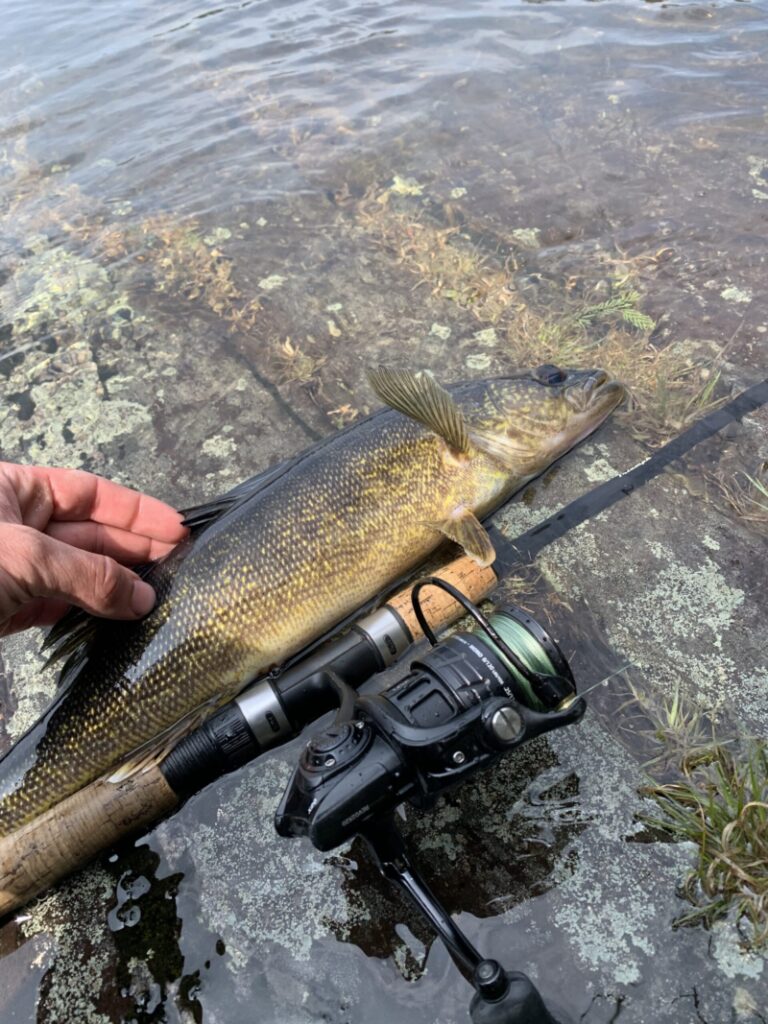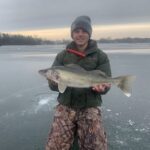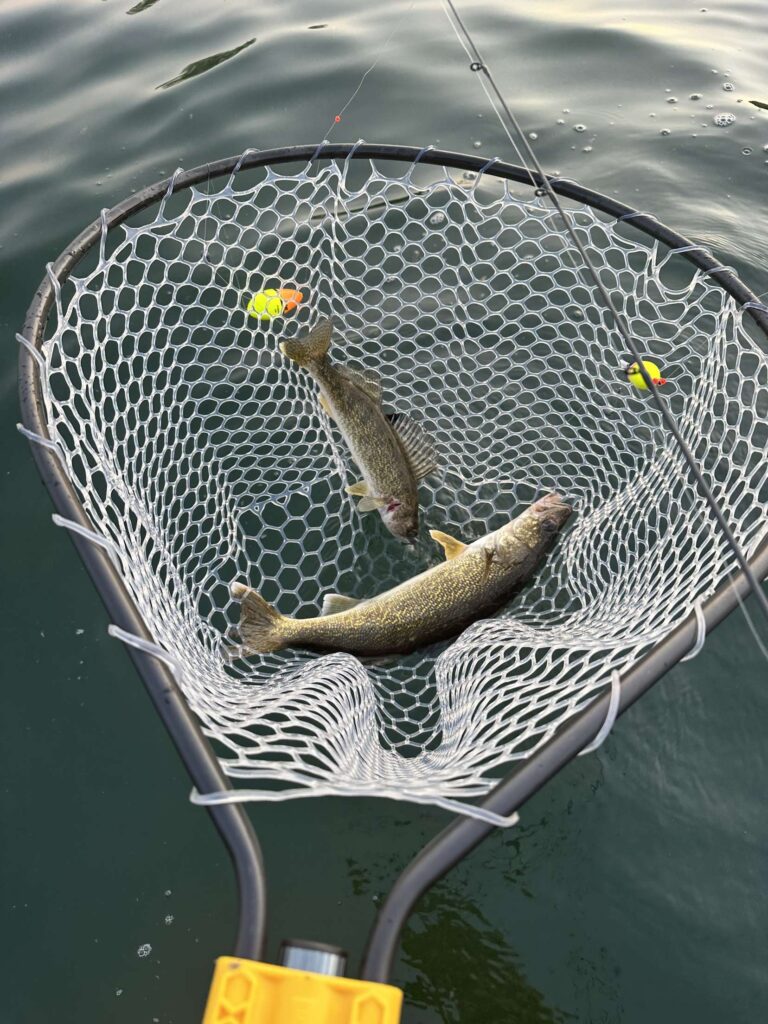Hey there anglers! It’s hard to talk about walleye fishing without mentioning live bait. Although artificial lures have come a long way in the world of walleye fishing, live bait still always seems to have a time and a place. The type of live bait that you choose and the live bait rig that you use is highly dependent on the time of year as well as many other factors. If you’re looking to up your walleye fishing game you’ve come to the right place. Whether you’re an experienced angler or just starting out, this guide will provide you with everything you need to know about fishing live bait for walleye.
As always, fishing education and conservation are our priorities here at The Angler’s Line. Feel free to sign up for our free newsletter to join our community and stay up to date! Lets get started!
Table Of Contents:
Types of Live Bait for Walleye Fishing
Alright, let’s talk bait. When it comes to live bait options, there are three main choices: minnows, leeches, and nightcrawlers.
- Minnows: These little swimmers are walleye magnets. When walleye are primarily targeting baitfish, minnows are the way to go. Fatheads, shiners, and chubs are all great options. Match the size of your minnow to the size of baitfish walleye are feeding on.
- Leeches: In certain lakes, walleye just prefer leeches for whatever reason. When using leeches, choose either large or jumbos for walleye. If you’re dealing with a lot of panfish, opt for larger sizes to keep them from constantly pecking your bait.
- Nightcrawlers: Nightcrawlers work for just about every freshwater fish species, and walleye are no different. If you are targeting big walleye and there aren’t many panfish around, feel free to use an entire nightcrawler. When fishing for smaller fish or in locations with panfish, using half a night crawler is generally the way to go.
Pro Tip: Experiment with different types of live bait to figure out what the walleye in your home lake. Every body of water is different.
Choosing The Right Live Bait Rig
Now that you know the main types of live bait, let’s talk about which live bait walleye rig to choose.

Bottom Composition
When determining which live bait rig to use, pay attention to the bottom composition. If you plan on fishing amongst weeds, use a live bait rig that is weedless or suspends above the top of the vegetation. Weedless jigs, slip bobbers, and spinner rigs are several great options.
Size of Structure
The size of area that you are targeting is crucial in determining which live bait rig to use. For large and expansive pieces of structure, use a rig that allows you to cover water. The spinner rig or lindy rig are two good choices. When walleyes are relating to a small area, choose a live bait rig that allows you to fish slowly and pick apart this location. The slip bobber rig or a combination of a jig and live bait are ideal for this scenario.
Water Depth
Water depth is another factor to keep in mind. Luckily, most live bait rigs can be fished in almost any depth depending on the size of weight you use. However, a few rigs such as slip bobbers and spinner rigs loose their effectiveness in depths greater than about 25′. Use these rigs when targeting shallower depths.
Main Rigs To Choose From
With the following factors taken into account, it’s time to make a decision. The main types of live bait rigs for walleye fishing include jigs, slip bobbers, lindy rigs, and spinner rigs. Check out our related article about the best live bait walleye rigs for more information.
Seasonal Considerations
The fishing seasons tends to be the biggest factor in determining which of the three live bait options to use.
Spring
In the spring, minnows are the deal a lot of the times. Shiners or fat head on a jig and minnow rig are deadly. Use smaller minnows this time of year and fish with the lightest weights you can get away with.
Summer
In the summer, leeches and nightcrawlers are the two preferred live bait choices for walleye fishing. Experiment in your lake to find what the walleye prefer. Keep in mind that walleye preference can change throughout the summer as well. Additionally, panfish can make fishing with nightcrawlers a real headache in certain bodies of water. If that’s the case for you, switching to a jumbo size leech can keep the panfish away a lot of the times.
Fall
In the fall, minnows come back into play. Not just any minnows, but large minnows. Bait is bigger this time of year, so match the hatch with your live bait rig for the best chances of success. Large chubs in the 4″ to 6″ range are very popular among anglers this time of year. You’ll have a great chance of a trophy as well using these big minnows.
Winter
In the winter, minnows are the way to go for walleye fishing. Unlike fall however, transition to smaller sized bait. Large fatheads or shiners are both great options. When ice fishing, you can either dead stick a live minnow or just use the minnow head tipped on a spoon. Either will work.
Choosing the Right Gear For Live Bait
Now that you’ve got your live bait, let’s talk gear. Choosing the right equipment is crucial live bait fishing success.

Rods
For walleye fishing with live bait, spinning rods are my preferred choice. You’ll want a rod with a soft tip since this will allow the fish to take the bait without feeling any resistance. A medium-light power spinning rod will cover almost all of the walleye live bait applications. Rod length is dependent on the specific rig you choose to use. For jigging applications, 6’6″ to 7′ is ideal. For drifting or trolling applications, 7′ to 7’6″ is ideal.
Line
Braided, monofilament, and fluorocarbon lines all have their time and place when fishing live bait. In general, I recommend a braided line and fluorocarbon leader for jigging applications since it provides the most sensitivity. When trolling or drifting, straight fluorocarbon or monofilament will do the trick. For slip bobber rigs, monofilament is ideal since it floats and allows the bobber the sit properly in the water. The big takeaway with line when it comes to fishing with live bait is to choose light line. Too heavy of line will impede the action of your bait and make your presentation look unnatural in the water. For braided line, 10-20 lb is good. For monofilament or fluorocarbon, 6-10 lb is good.
Hooks
When looking for live bait hooks, look for thin wire hooks. Firstly, thin wire hooks will allow you to properly set the hook on light line. Additionally, thin wire hooks minimize the damage caused by hooking the live bait, keeping it lively in the water.
Bonus Tip: Consider using barbless hooks for live bait fishing if you plan on practicing catch and release. Fish tend to be hooked deeper with live bait and barbless hooks can minimize handling time and overall harm.
Conservation and Ethical Fishing Practices
As responsible anglers, it’s crucial to prioritize conservation and practice ethical fishing
Catch and Release
Adhere to catch-and-release guidelines whenever possible to preserve the walleye population for future generations. Handle fish with care, use barbless hooks to minimize injury, and return them to the water as quickly and gently as possible. If you plan on keeping a few fish for a meal, release the larger fish to let them spawn.
Regulations and Limits
Stay informed about local fishing regulations and adhere to size and bag limits. These limits are in place to ensure sustainable fish populations and healthy ecosystems. Ignorance is no excuse, so take the time to familiarize yourself with the specific regulations in the areas you fish.
There you have it – everything you need to know about live bait fishing for walleye! Whether your like it or not, there always seems to come a time in the world of walleye fishing were you have to use live bait. Remember to pay attention to the time of year and location that you are fishing to choose the appropriate rig and type of live bait. Additionally, set yourself up with the right gear for the job. So put your newfound knowledge to the test the next time you’re out on the water. Tight Lines!
More Walleye Articles:
- Ice Fishing For Walleye: Everything You Need To Know

- Midday Walleye: A Complete Breakdown Of Daytime Walleye Fishing

- Live Bait For Walleye: Everything You Need To Know

- Lure Talk: Full Guide On Fishing Crankbaits For Walleye

- Lure Talk: How To Fish Spinner Rigs For Walleye

- Trolling For Walleye: Everything You Need To Know

